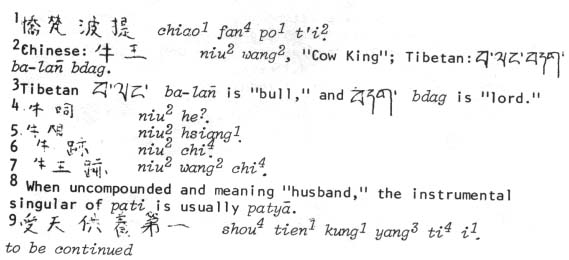Sanskrit Lesson
![]()
Gavampatina ca "and Gavampati"
(continued from issue #50)
by Bhiksuni Heng Hsien
Yet
another Great Arhat in the Assembly when the Buddha spoke the Amitabha Sutra
was the Venerable ![]() Gavampati.1 His
name translates as "Lord of the Cows."2
Gavampati.1 His
name translates as "Lord of the Cows."2
![]() pati meaning
"lord" or "husband," and
pati meaning
"lord" or "husband," and ![]() gavam
meaning
"of cows." It is unusual
to have an inflected form--
gavam
meaning
"of cows." It is unusual
to have an inflected form-- ![]() gavam
is genitive plural-- as the first part of a compound, but such compounds are
found, especially, as here, with
gavam
is genitive plural-- as the first part of a compound, but such compounds are
found, especially, as here, with ![]() pati
as the final
member. Note that
pati
as the final
member. Note that ![]() gavam is written
gavam is written ![]() gavam, that is with m (anusvara, indicating
a sound change that takes place
gavam, that is with m (anusvara, indicating
a sound change that takes place ![]() ,
m whenever m comes directly before another consonant. The singular of
,
m whenever m comes directly before another consonant. The singular of ![]() gavam
gavam ![]() is in the stem (non-inflected) form. If
masculine
it means, "bull," and if feminine it means "cow."
is in the stem (non-inflected) form. If
masculine
it means, "bull," and if feminine it means "cow." ![]() Gavampati
sometimes means simply "a bull."3
Gavampati
sometimes means simply "a bull."3
The
Elder Gavampati received his name because for many lives he had
been reborn as a cow as retribution for having mocked a toothless
Pratyekabuddha's eating habits, comparing the sage to a cow chewing its cud.
When finally reborn as a man, he still retained some characteristics from his
lives as a cow, and when he ate he still chewed his cud. The Chinese therefore
variously translated his name as "Cow-Cud,"4 "Cow-like,"5
"Traces of a Cow."6 Or even "Cow-King Traces."7
The noun ![]() pati
meaning "Lord"
or "husband" belongs to a class of nouns that end
in short -i, and so the ending called for by the preposition
pati
meaning "Lord"
or "husband" belongs to a class of nouns that end
in short -i, and so the ending called for by the preposition ![]() Sardham "together with,"
which occurred previously in the text, is different from the ending -ena
which marked the end of the names of the other Arhats so far mentioned. That
accounts for the form
Sardham "together with,"
which occurred previously in the text, is different from the ending -ena
which marked the end of the names of the other Arhats so far mentioned. That
accounts for the form ![]() Gavampatina, which is instrumental singular.8 Note the final long -a
which
was also found in the instrumental singular forms
Gavampatina, which is instrumental singular.8 Note the final long -a
which
was also found in the instrumental singular forms![]() maya "by me," and
maya "by me," and![]() mahata
"great" earlier in the text.
mahata
"great" earlier in the text.
Inflection means the addition of endings, varying according to gender and indicating number and case (function), to nouns, pronouns, and adjectives. Sanskrit has three genders: masculine, feminine, and neuter; three numbers: singular, dual, and plural; and eight cases: 1) Nominative/subject, 2) Accusative/direct object, 3) Instrumental/means or accompaniment, 4) Dative/indirect object, 5) Ablative/cause or origin, 6) Genitive/ possession, 7) Locative/location in time or space, and 8) Vocative/direct address. The system of inflection will be described at greater length in future Sanskrit lessons.
The Buddha had the Venerable Gavampati reside in the heavens where the gods were not dismayed by his cow-like habits, since they could see the past causes. If he had continued to reside among men as an Arhat, anyone who mocked him would have suffered a fate similar to his! The Elder Gavampati was therefore foremost among the Buddha’s disciples in receiving the offering of the gods.9
